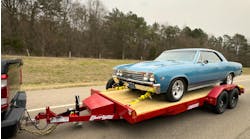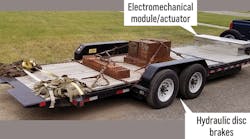General Motors currently is studying trailer braking in an effort to develop an advanced system capable of stopping a truck and trailer in the same distance as a truck alone.
Todd Brinkman, a trailering systems engineer for GM with 30 years of experience in the field, provided an update on the ongoing project, including current status, factors to consider in the pursuit of improved trailer braking, and next steps, in the National Association of Trailer Manufacturers’ technical forum “Next Generation Trailer Braking System” during the 31st Annual NATM Convention and Trade Show in Lake Buena Vista, Florida.
Their goal, Brinkman said, is to design a trailer braking system that decelerates with a g-force of .77 g x the trailer’s axle load, which is equivalent to the force a truck’s brakes generate in a panic stop from 60 mph, which brings the truck to a full stop in 167 feet at its gross vehicle weight rating (GVW), according to GM’s work.
By comparison, the Canadian Standards Association standard is .35 g x axle load, so GM is aiming for a force roughly twice the Canadian standard.
“It would have to be a partnership between the brake manufacturer and the trailer manufacturer, because when you think about it, all those loads would be going into every aspect of the trailer … and the first thing you think of is the attachment of the axle to the trailer frame,” Brinkman said. “So it probably wouldn’t be something where you could come up with a brake system like this, give it to the customer and let them bolt it to any trailer with the existing brackets, because you’d really have to understand all the forces involved.”
Braking badly
Brinkman traced his interest in trailer braking to his teenage years, when he was towing a boat trailer as soon as he received his driver’s license. As an adult, he and his family toured the country with a travel trailer, and Brinkman said he always stayed safe by following his dad’s advice – stick to the right and avoid panic stops.
But his luck finally ran out while towing a boat on a trip to Canada when a bear cub decided to cross the road in front of him – and he realized at the worst possible moment that his trailer brakes weren’t working.
“It felt like I was on black ice,” Brinkman recalled.
“The truck was getting pushed by the boat, and I started negotiating with God and he saved me. I can’t commit murder now, because I promised I wouldn’t do that … (and) from that point I realized the brakes on the trailer are pretty important.”
That experience fostered a greater appreciation for trailer braking, which he eventually turned into a career with GM. Now he works with the vehicle manufacturer’s Vehicle Dynamics Group, which develops brakes for full-size towing trucks and certifies vehicles to the Society of Automotive Engineers’ J2807 towing standard, and GM’s Integrated Trailer Brake Control group to further the company’s trailering vision.
One of their most important current projects, which involves 88 test trailers, is the advanced trailer braking study.
Study considerations
The study began with a two-part question from GM’s chief engineer: What would it take to stop a truck with the trailer attached, all the way up to the max rating, in the same distance as a truck alone? And, looking at all factors from a design standpoint, is it possible to accomplish this feat in a production vehicle?
GM’s testing established 167 feet as the stopping distance for a heavy-duty pickup at GVWR, so that distance became the target point for the truck and trailer. Their work also showed an ABS (anti-lock braking system) trailer weighing 14,000 pounds stopped in 202 feet, a 14,000-pound trailer with electric/hydraulic brakes stopped at 231 feet, and a 14,000-pound trailer with electric brakes came to a complete stop in 261 feet.
Brinkman said most trailer towers, and drivers in general, are comfortable with a 2-second following distance, believing that’s enough time to stop if the driver in the vehicle in front of them slams on their brakes, but that’s not necessarily the case, which is why improving trailer braking is important, and potentially life-saving.
“At some point, if your brakes on the truck and trailer aren’t good enough combined, and you’re following something that can stop a lot faster, you could be in an unsafe situation without really realizing it,” he said.
Factors that affect stopping distance include the trailer’s maximum brake torquing capability, trailer brake system response time, trailer ABS efficiency, trailer tire traction and trailer brake gain adjustment efficiency.
Tire braking force also depends on whether the tire is rolling or skidding, and the amount of weight on the tire.
“Our safety engineers consider skidding to be a worse safety case than losing trailer brakes altogether, because if the tire starts skidding, now you could potentially lose control of the trailer and experience a jackknife situation,” Brinkman said.
Selecting the right tire for the trailer is a critical component in an advanced trailer braking system, as is appropriately adjusting the trailer brake gain, which is tricky when done manually. If the gain’s too high, the tires can skid, and gains aren’t optimized for each tire and must be readjusted depending on load and conditions.
Coupling complicates
The first stage of GM’s study involved establishing the weight put on each section of a truck alone (with cargo and passengers), and then a truck and trailer, when panic-stopping from 60 mph. Brinkman said their simulations show 2,632 pounds at the back of the truck, and 6,871 at the front as the weight rocks forward during the stop, thus the front brakes must be bigger to handle the higher load forces during a panic stop.
But with a truck and trailer combo in a panic stop, the force on the truck is more evenly distributed, with slightly more weight on the truck’s rear axle, and the trailer bears most of the load force, which Brinkman said is significantly lessoned by enhanced trailer brakes. In addition, trailer tongue weight increases loading on the rear axle, allowing the truck tires to achieve better braking traction.
In other words, stopping a truck with a trailer attached is a much more complicated endeavor than stopping the truck alone.
“For a GVW stop, you have to pay attention to the loading on the front, and then with braking with the trailer, you have to take a different load case into account because you have more loading on the rear as well,” Brinkman said.
Since the truck in this equation already is doing about as much as it can to stop itself and the trailer, GM wants to improve trailer braking, with an enhanced system able to improve stopping by putting less weight through the coupler onto the truck and increasing trailer braking force. But how, exactly, is this achieved?
Proof of concept
GM considered three types of trailer braking systems – ABS electric drum, ABS electric/hydraulic disc and electro-mechanical – before settling on the new electro-
mechanical system already found on its T1 full-size pickups for its initial test.
The system is a hydraulic disc brake system that uses an electrically controlled power piston to generate brake pressure, so it’s a vacuum-less system with no master cylinder that can be controlled completely electronically. The system combines pressure boost and ABS/electronic stability control (ESC) pressure modulation in an integrated unit with braking by wire that creates very high braking force, Brinkman said.
The system is capable of achieving combined stopping distance equivalent to a truck alone, and allows for the implementation of trailer based stability controls, he said, but it’s never been done before, and would consume a large amount of electrical power during a panic stop – possibly more than the vehicle could produce.
“We wanted to consider this as one of the options because this is a new technological evolution that wasn’t available in the past,” he said.
“So, in the past, for truck-type brakes, you needed to have the driver input, you needed the master cylinder on it, but with this new technology, the thought is, ‘Well, what would happen if you put this on the trailer?’ Because, really, the hurdles that kept the vehicle-style technology from going on the trailer no longer exist with this new technology.”
GM used only off-the-shelf components and hydraulic disc brakes for the first run, and attached its electromechanical control module/actuator (with a modified version of the truck software performing the four-corner ABS function on the trailer) to a 9,000-pound test trailer to produce some promising results.
The trailer stopped in less than 200 feet in a 60-mph panic stop, compared to a standard test trailer with CSA-rated brakes, which came to a complete stop closer to 220 feet.
Next steps
However, with the goal of stopping a 14,000-pound trailer at 167 feet, they still have work to do, Brinkman said.
For Phase 2, GM plans to develop a production-feasible design utilizing components engineered to match the stopping distance of the truck alone, with ideal-size tires, correctly proportioned brakes and other modifications.
“We’re in the process of going through the calculations on figuring out what brake forces we would need, and then based on those forces, what kind of hardware would we want to use on the next trailer, what kind of pressures we would have to operate at, and what kind of currents it would draw, so we’re still on the paperwork, doing our figuring for the next phase,” Brinkman said.
GM hopes to have Phase 2 put together by early next spring, Brinkman said.
“For the next phase of our experiment, we want to see how far we can push the envelope with a heavier trailer,” he said.











